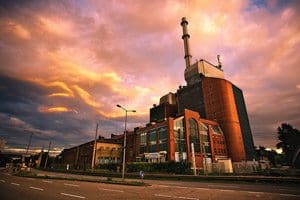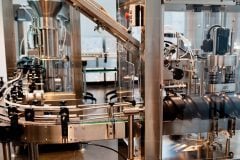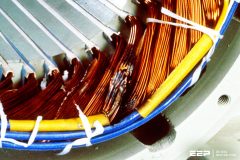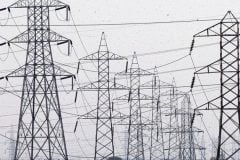District heating
District heating is a system which provides a number of buildings with heat from a central boiler plant through pre-insulated pipes.
Pre-insulated pipes are in fact a modern kind of heat culvert or district heating duct, but since these systems nowadays are pre-manufactured, they will from here on be referred to as pre-insulated pipes.

The smallest systems cover 200-300 houses or a block. The connection to the secondary heating system can be direct or indirect, i.e. with or without a heat exchanger.
Domestic hot water is also produced with the help of district heating. As a result, the heating plants are also in operation during non-heating seasons. There is a difference between heating plants, pure heat producers and combined heat and power plants. The main purpose of the last-named is to produce electricity through a steam turbine.
The connected buildings are used to cool down the condensate to such a low temperature as possible in order to increase the capacity of the steam turbine. The efficiency for coal-fired power plants is low, 30-40 %. By combining the power production with the heat delivery, the efficiency has increased right up to 90 %, which corresponds to the efficiency of well-kept district heating plants.
A district heating plant, (the primary circuit), can be divided into three parts:
- Production (central boiler plant)
- Distribution (pre-insulated pipes)
- Consumption (sub-station)

In the production plant, the water temperature is increased to the required level. Distribution implies heat transfer to the consumers with as small a loss as possible.
Consumption implies heat transfer from the water of the primary side to the water of the secondary side, and a large temperature drop in the primary water. It may also imply directly connected systems, detached houses for instance, with a differential pressure control as protection against too high differential pressures.
District heating systems with a large production plant, an efficient distribution network and a sub-station with heat exchanger and automatic controls, can be made very effective in respect of consumption as well as pollution.

The choice of material and operating conditions such as static pressure, temperature and water quality are important factors concerning the operation of the system, its maintenance and its durability. The heating system in a building, (the secondary circuit), can be divided into three parts:
- Production (heat transfer through the heat exchanger)
- Distribution (the main piping system of the building, including the circulation pump)
- Consumption (radiators, convectors, or floor heating for the rooms)
In the production plant, the secondary water temperature is increased to the required level. Distribution implies heat transfer to the consumers with the smallest losses possible and small temperature drop.
Consumption implies heat transfer from the water to the rooms and large temperature drop in the water.
Reference: Danfoss – The Heating Book











Thank you for this detailed information! This is some of the highest quality content I’ve ever come across…
Nice article. thanks for sharing.